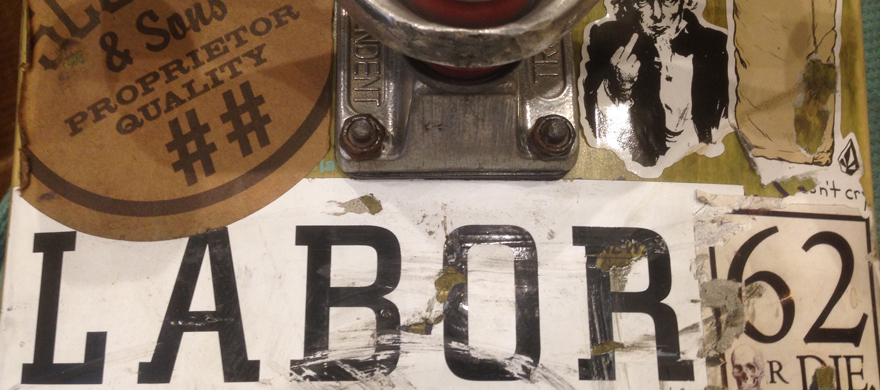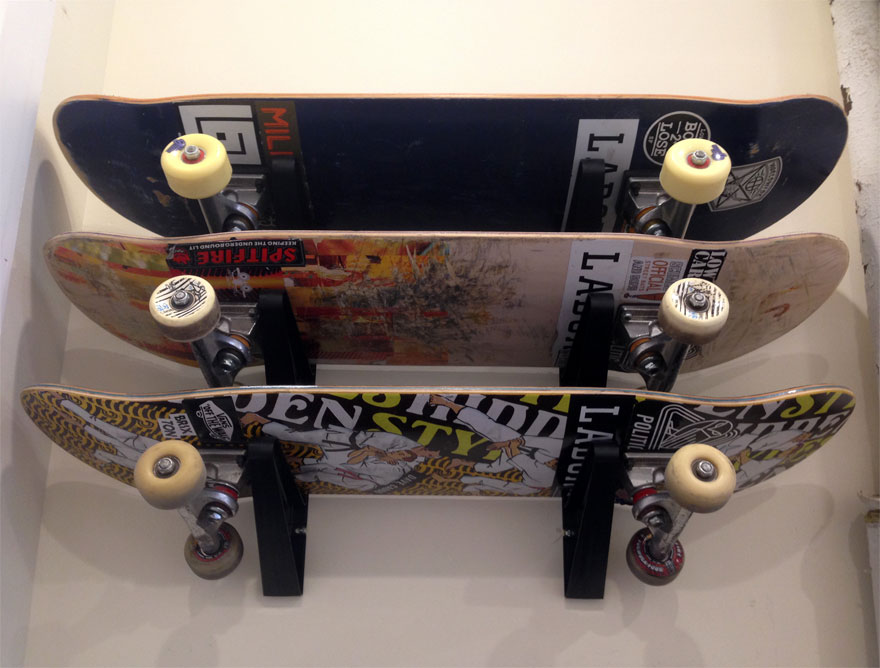
One of the most frequent questions I get asked by people who find this blog is “I want to start skateboarding again, what should I get?” So, this post is the first in a series of guides I will be writing and will hopefully help answer that question.
The short answer to “what should I get?” is go to your local skate shop, get an 8.25” popsicle deck with whatever trucks they have and 54mm hard wheels.
In all honesty, it doesn’t matter much what you get. This first board is to just get you started. You will figure out what works for you by actually skating. That said, I know that I did a lot of online research and wanted a lot more information when I was thinking of starting again, so what follows are my opinions and justifications for my recommendations.
First, support your local skate shop! This is important. If you have a local shop, go there to buy your stuff! Do not buy a big box store garbage board or a complete online. The internet has disrupted skate shops like most other brick and mortar retailers, so it is increasingly important to support them. You will probably be intimidated and feel like a poseur. Guess what? No one cares. If you want to start skating again you are going to have to get used to feeling like that. The local shop will also be able to answer any questions you have much better than randoms like me on the internet. Plus, you can get cool shop stickers, like the LABOR one in the header image above, to put on your board!
For the past few years I have been running two set-ups, the first almost identical to what I suggested above and a slightly larger, big bowl, set-up. What you choose is going to be based on what you will be skating. If you are only skating flat you may go a step down if that feels better to you. If only big transition, then a step up. Differences of ¼ inches or 2 millimeters may not seem like much but those difference become increasingly noticeable the larger they become.
Decks
Size is your first and main choice in decks. If you are a 30-40 year old coming back to skating you either rode a 9”-10” wide shaped board or a 7” popsicle when you were young. You are not doing either now. I see this all the time, guys who decided to start skating again and bought something like what they rode as a teenager out of nostalgia. Be it a Powell or Santa Cruz reissue with no nose and no concave or a tiny deck with tiny wheels, both are relics of a different time and place. You are an adult and that was decades ago. There is a reason boards are shaped and sized as they are now and riding something the wrong size is just going to handicap you. The most common sizes for decks are between 8”-8.5” inches now, anything smaller is for children. Buy an 8.25” to start with and fine tune your size on your second and third deck.
A more advanced size consideration, which frustratingly is almost never listed, is wheelbase. Most boards will come in at around 32” in length but the wheelbase will vary by brand. Again, like width, this will vary only by a ½ inch or so, with the standard 8.25” coming in at 14.25”. Just like with how smaller width boards will flip quicker, smaller wheelbase boards rotate easier, while larger boards will feel more stable at speed. Don’t particularly worry about this initially, but later wheelbase will likely become as important to you as width.

My current quiver. Top to bottom. Cruiser 8.5 Mini Logo, Indys, 58mm OJ Keyframe Filmer Wheels. Bigger Tranny 8.5 Killing Floor, Indys, 58mm Bones SPFs. All Terrain 8.25 Politic, Indys, 55mm Spitfire Formula Fours
There will also be differences in concave that are impossible to put in to measurements, which is yet another reason to visit your local shop. You can stand on the decks to see how they feel to you. I prefer a steeper concave but one of my earlier boards, which I bought off the internet, was too steep and felt odd and distracting, like it was constantly digging in to my front foot. I replaced it very quickly. I would have saved $50 if I’d just gone to my local shop.
A final consideration is wood. The conventional wisdom is that Canadian Maple is vastly superior to Chinese Maple, which is normally used for price point decks and big chain store brands. Many large brands still have their decks made in China using North American wood though. The difference here is debatable. I prefer to buy smaller American made brands and have been riding a series of Politic, Scumco & Sons and Killing Floor decks, so I know that those shops and shapes work for me. Anti-Hero is my go to for the larger brands. At this point I am reticent to try anything different.
Trucks
I ONLY ride Indys. I’ve been brand loyal to Independent since sometime around 1986. Back then it was Indy vs. Tracker. Indy was NorCal, Thrasher and punk rock. Tracker was SoCal, Transworld and, in my opinion, lame. Those kinds of divisions don’t really exist anymore. I am sure any of the major brands of trucks are fine, just make sure you get the appropriate width truck for you deck. If you don’t know what that is, look this up or ask at your local shop. Don’t worry about lows or hollows or anything out of the ordinary. Those are the kind of things you can experiment with later if you think you may like them.
I personally prefer standard Indys. The only thing I replace is the stock bushings with softer, aftermarket ones. Trucks are one of the worst things to break in so once you have a pair you normally ride them until they break.
Wheels
I would suggest riding hard wheels. Softer wheels are fun for cruising but do not have the speed and slide I like. Your local shop will have quite a number of different wheels, all of which are fine, but there are two industry leaders, Bones and Spitfire. Bones has the STF (103A or 83B) and the SPF (104A or 84B), while Spitfire has Formula Fours in 99a and 101a. These two pairs of wheels are essentially the same in terms of performance. Which you may prefer will come down to the intangible “feel”. I am a recent convert to Spitfires after riding Bones for years.
As for size, as I said at the start to this post, I recommend 54mm for an all-terrain wheel. Just like board size, the rule of thumb is smaller is for more technical street skating. I personally don’t like riding wheels smaller than 50mm, to me that feels too slow and not friendly on rougher surfaces. I had been alternating between a set of 56mm and 54mm Bones wheels and decided to split the difference and chose 55mm when I switched to Spitfire. This lets them cone and get flipped a few times before they start to feel too small for me. On my larger board I’m riding 58mm. In bowls you will notice a substantial increase in speed with larger wheels. Anything larger than 58mm is overkill unless you are skating huge stuff.
Wheels also come in a variety of shapes, which is normally just the width of the riding surface and the cuts of the sidewalls. Again, this is something to not worry about initially, but you may later find you prefer something as you dial in your set-up.
Bearings
All the cheap bearings will function the same. They are also cheap enough to be considered disposable. I tend to buy Bones Reds and keep them and clean them when they get shitty. I can normally salvage a few, which I keep in my skate bag in case they are needed. The more expensive, swiss and ceramic bearings will feel very fast and spin forever but unless you are fastidious with the cleanings the lifespan of that performance may not be worth the cost.
Grip Tape
This doesn’t matter at all, get whatever is free with your deck. If given a choice I go with Jessup. It’s finer grained then Mob. My personal opinion is don’t get Shake Junt or anything with some all-over print bullshit, unless you want to look like a 13-year-old. Adults ride plain black grip tape. If you want to get creative and break out the razor blade and paint pens and do a fancy grip job, that is up to you, just don’t buy some pre-made garbage.
Hardware
This matters even less than grip tape. I tend to get one of the many brands with one different colored bolt because I like to put that in the front for easy reference.
Shoes
Shoes are extremely personal so I’m not even going to try here other than to say don’t buy something with canvas at the ollie spots unless you want to replace your shoes every couple of weeks. Most brands sell more fashion oriented models of their skate shoes as well so make sure you are getting something with rubber, leather or suede in the spots that will rip up. You will likely have to try several different brands and styles until you find something you like. I’d suggest reading the reviews and recommendations on Ripped Laces.
Personally? After bouncing around a bit I’m now on my third pair of Kyle Walker Vans and will probably stick with these until they significantly change them.
What Else?
Buy a skate tool. It will make your life a lot easier.
You will also eventually want a skate bag, something that can hold your pads and that you can strap your board to. I keep mine stocked for all eventualities, so I can just grab it and go. Besides my pads, it also holds my skate tool, some old bearings, a few old bolts, small first aid kit, wax, tissues, sunscreen, matches a chamois rag, a hat, a lightweight shell, a bandanna, water bottle and a tall boy koozie. It’s probably overkill but I have been glad to have all of the above on multiple occasions.

Absolutely solid advice, on every level. The *only* nuanced thing I might add is go for Indy FORGED trucks, as opposed to standard Indys. When Indy made the Stage 11 trucks, they made the standard version taller than every previous truck they ever made. They shouldn’t have fixed what wasn’t broken. The forged trucks remain the old height. Many people think the new, taller, standard trucks don’t feel quite as stable as the older version because of the height. That said, the standard Indy is still a totally solid choice. And just makes sure it’s the FORMULA FOUR spitfires, and NOT regular spitfires, there is a HUGE difference in quality between the two of them!
I also have a old military ammo can that I keep all that “overkill” stuff (softer wheels for rough pavement, extra bearing, first aid, extra laces, hardware, wax, tools, etc.). Something in there always comes in helpful to someone I am skating with!
Pat if I had read this post three years ago it would have saved me a lot of trouble.